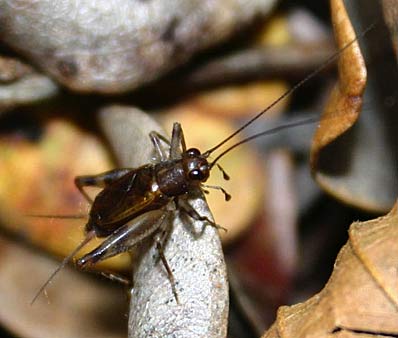Biology professor at Lehigh University

|
Isle cricket
judged world’s
fastest-evolving
invertebrate
Hawaii's Laupala cricket is the world's fastest-evolving invertebrate, thanks to its mating behavior, two mainland biologists have found.
Tamra Mendelson, biology professor at Lehigh University in Pennsylvania, and Kerry Shaw, University of Maryland evolutionary biologist, studied the thumbnail-sized cricket in Hawaii forests for three and a half years.
In an article in the Jan. 27 issue of the journal Nature, they said 4.17 new Laupala species are evolving every million years -- more than 10 times faster than the average speciation rate for invertebrates.
The rapid evolution is contributing to an "explosion" of new cricket species in Hawaii, especially the Big Island, youngest island in the chain, the biologists said.
A couple of crickets probably blew over there from Maui and are evolving rapidly because of geographic isolation, Mendelson said in a telephone interview. "Every new eruption is a new habitat, a new place for a new species to form."
She said 38 species of Laupala -- called uhini iki in Hawaiian -- have been described, each native to a particular island. The oldest are on Kauai; the youngest on the Big Island.
They include 12 species on Oahu, 12 on Maui and Molokai, seven on Kauai and seven on the Big Island. Lanai used to have a species that may be extinct, Mendelson said.
Some species have male genitalia differences, but the key difference in the groups is song, Mendelson said.
The findings suggest behavioral differences may be enough for new species to form, she said. "Ecological differentiation, adaptation to a novel food source or environment may be unnecessary."
Male crickets sing during courtship with pulses ranging from 0.5 to 4.2 a second, Mendelson said. The females don't sing, but can detect tiny differences in the male pulse rates, which sound like sleigh bells, she said.
The females tend to hop toward the pulse rate of their own species and reject males of other species singing at a different tempo, she said.
Sometime in the morning, she said, "The male will go out and find a place to sing from, and he pretty much stays there and sings. The female uses the song as a homing beacon to find a male to mate with."
The two spend the entire day mating, with singing, courting and "nuptial gifts," she said, adding that it's unusual for any organism to spend that long in courtship.
The male is almost constantly singing, and the crickets have antennae longer than the body that they use to rub each other, Mendelson said.
Every hour until about dusk, the male gives the female spermatophores that have no sperm, she said. "Just before the sun goes down, the male will produce sperm and transfer it to the female."
New species evolve that don't recognize each other, although they had common ancestors, she said.
[News] [Business] [Features] [Sports] [Editorial] [Do It Electric!]
[Classified Ads] [Search] [Subscribe] [Info] [Letter to Editor]
[Feedback]
